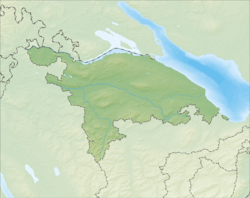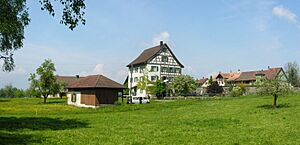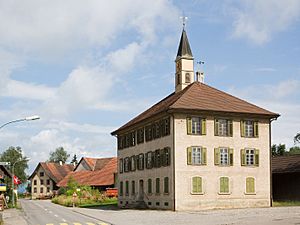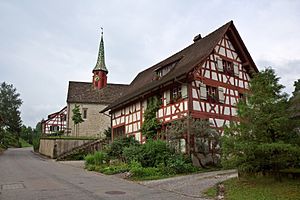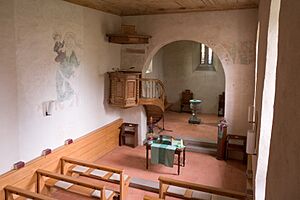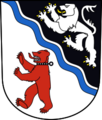Basadingen-Schlattingen facts for kids
Quick facts for kids
Basadingen-Schlattingen
|
||
|---|---|---|
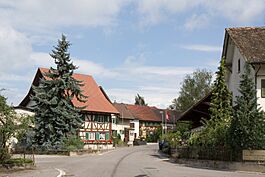
Village street in Schlattingen
|
||
|
||
| Country | Switzerland | |
| Canton | Thurgau | |
| District | Frauenfeld | |
| Area | ||
| • Total | 15.63 km2 (6.03 sq mi) | |
| Elevation | 410 m (1,350 ft) | |
| Population
(Dec 2020 )
|
||
| • Total | 1,818 | |
| • Density | 116.31/km2 (301.25/sq mi) | |
| Postal code |
8254
|
|
| Localities | Basadingen, Schlattingen | |
| Surrounded by | Diessenhofen, Schlatt, Truttikon (ZH), Unterstammheim (ZH), Waltalingen (ZH) | |
Basadingen-Schlattingen is a municipality (a type of local government area) in the Frauenfeld District of the canton of Thurgau in Switzerland. It was created on January 1, 1999, when the two separate municipalities of Basadingen and Schlattingen joined together.
History of Basadingen-Schlattingen
The area of Basadingen-Schlattingen has a long history. Basadingen was first mentioned in records in the year 761. Schlattingen appeared in records later, in 897.
Basadingen's Past
People have lived in Basadingen for a very long time. Evidence shows settlements from the Neolithic period (the New Stone Age). There was even a Roman villa (a large country house) with graves found here.
In the early Middle Ages, several monasteries (religious communities) owned land in Basadingen. These included St. Gallen, Rheinau, Reichenau, and Allerheiligen. Over time, the St. Katharinental monastery bought more and more land. By 1330, it owned much of the village. It also had rights to the "low courts," which meant it could handle smaller legal cases. The city of Diessenhofen later gained control of the "high court" rights, dealing with more serious crimes.
The village had different church arrangements over time. In the 13th century, St. Martin's Church was built. After the Protestant Reformation in 1529, the church became shared. This meant both Protestants and Catholics used the same church, a practice called a Simultaneum. This tradition continues even today.
The number of farms in Basadingen changed a lot. It went down in the Middle Ages but then doubled between 1470 and 1550. For a long time, Basadingen was mainly a farming village. Around 1970, things started to change. More people moved in, and the village grew.
Schlattingen's Past
Like Basadingen, Schlattingen also has ancient roots. Tools and items from the Paleolithic (Old Stone Age) and Roman era have been found. This shows that people lived here thousands of years ago.
During the Middle Ages, several monasteries also owned land and had rights in Schlattingen. These included St. Gallen, Münsterlingen, St. Katharinental, and Wagenhausen. The town of Diessenhofen gained control of the local courts in Schlattingen.
The village church was built in 1275. After the Protestant Reformation, Schlattingen's church became part of the Stammheim parish. Later, in 1827, it became a "filial church" of Basadingen. This means it was a smaller church connected to the main Basadingen parish.
In the 18th century, the village owned a lot of its own land, including forests. Farmers grew grains, fruits, and grapes. In the 19th century, dairy farming became more popular. Over time, fewer people worked in farming. More jobs appeared in other areas, like services. New homes were built, and the village continued to develop.
Geography of the Municipality
Basadingen-Schlattingen covers an area of about 15.64 square kilometers (about 6 square miles). A large part of this land, about 60%, is used for farming. Forests cover about 31% of the area. The rest of the land is used for buildings, roads, or is made up of rivers.
The municipality is located in the Frauenfeld District. It includes the main villages of Basadingen and Schlattingen. It also has smaller communities called Mett-Oberschlatt and Unterschlatt.
Population and People
Basadingen-Schlattingen has a population of about 1,700 people. As of 2008, about 11% of the people living here were from other countries. Most people in the municipality speak German, which is the main language. A smaller number of people speak Albanian or Italian.
The population is almost evenly split between males and females. In 2008, there were slightly more Swiss men and women than non-Swiss residents. The total population grew by about 2% in 2008.
The age groups in Basadingen-Schlattingen show a good mix. About 10.5% of the population are young children (0-9 years old). Teenagers (10-19 years old) make up about 13.3%. Adults between 20 and 59 years old make up the largest part of the population. There are also older adults, with about 10% being between 60 and 69 years old.
Most people live in private homes. In 2000, there were about 567 households, with an average of 2.7 people per home. Most buildings were single-family homes.
Economy and Jobs
Basadingen-Schlattingen has a low unemployment rate, which means most people who want to work can find jobs. In 2005, many people worked in the primary economic sector, which includes farming. Others worked in the secondary sector, like manufacturing. A good number of people also worked in the tertiary sector, which includes services.
Many people who live in Basadingen-Schlattingen travel to other places for work. Also, some people travel into the municipality to work here. About half of the working population uses a private car to get to work. A smaller number use public transportation.
Religion in the Community
According to the 2000 census, about 27% of the people in Basadingen-Schlattingen were Roman Catholic. About 50% belonged to the Swiss Reformed Church (a Protestant church). There were also smaller numbers of people who belonged to other Christian churches, the Orthodox Church, or Islam. Some people said they had no religion, or did not answer the question.
Education Opportunities
Switzerland is known for its good education system. In Basadingen-Schlattingen, many adults have completed higher education. This means they have gone beyond basic schooling. About 75% of people aged 25 to 64 have finished either non-mandatory upper secondary education (like high school) or even higher education, such as university or a Fachhochschule (a type of professional university).
Images for kids
See also
 In Spanish: Basadingen-Schlattingen para niños
In Spanish: Basadingen-Schlattingen para niños




